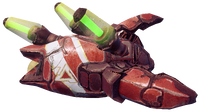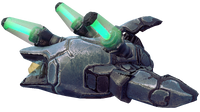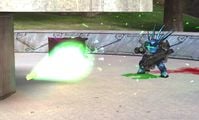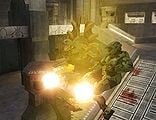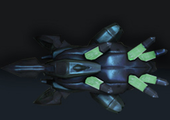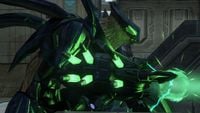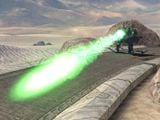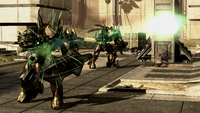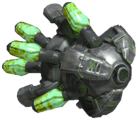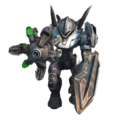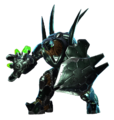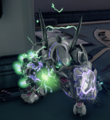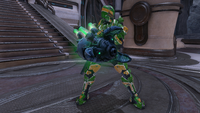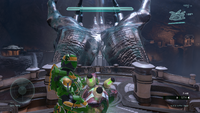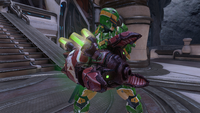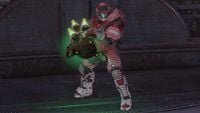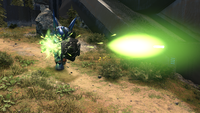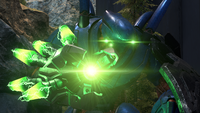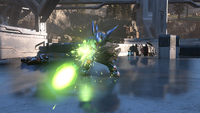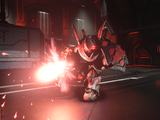Assault cannon: Difference between revisions
From Halopedia, the Halo wiki
mNo edit summary |
BaconShelf (talk | contribs) mNo edit summary |
||
| Line 1: | Line 1: | ||
{{Status|Canon}} | {{Status|Canon}} | ||
{{Center|Looking for the closely related Covenant vehicle weapon, the [[fuel rod cannon]], or for the handheld [[Pez'tk-pattern fuel rod gun|fuel rod gun]]?}} | {{Center|Looking for the closely related Covenant vehicle weapon, the [[fuel rod cannon]], or for the handheld [[Pez'tk-pattern fuel rod gun|fuel rod gun]]?}} | ||
{{Weapon infobox | {{Weapon infobox | ||
|image=[[File: | |image=[[File:Halo Reach Hunter Assault Cannon.png|300px]] | ||
|name=Assault cannon | |name=Assault cannon | ||
|manufacturer= | |manufacturer= | ||
| Line 66: | Line 65: | ||
<gallery> | <gallery> | ||
File:H5G Berserker' | File:H5G Berserker'sClaw Crop 2.png|Berserker's Claw. | ||
File:H5G WickedGrasp Crop 2.png|Wicked Grasp. | |||
</gallery> | </gallery> | ||
Revision as of 11:31, December 2, 2024
| Assault cannon | |
|---|---|
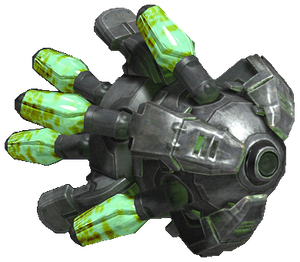
| |
| Production overview | |
|
Type: |
|
| Specifications | |
|
Length: |
2 meters (6 ft 7 in)[1] |
|
Ammunition type: |
|
|
Feed system: |
Unlimited |
|
Continuous fire | |
|
Effective range: |
Long |
| Service history | |
|
In service: |
|
| “ | The Mgalekgolo opened fire with their assault cannons, the weapons making a sound that was like the bellowing of some gigantic primordial beast.[2] | ” |
The assault cannon[3][4] is a powerful weapon used by the Covenant. Functioning based on the same principles of the Pez'tk-pattern fuel rod gun,[5], it is most commonly utilized by Mgalekgolo, although the Hierarchs' anti-gravity chairs are equipped with a variant of the weapon.[6]
Overview
Design details
The standard version of the Assault cannon is incredibly heavy, making it suitable only for Mgalekgolo. The weapon is integrated into the right "arm" of the Mgalekgolo's armor. In most models, the nozzle is surrounded by three metal "fingers", which may serve as manipulators or assist in the guiding of the projectile. The weapon has shown three primary firing modes. The first one encountered fires the incendiary gel in globs similar to the standard fuel rod gun,[7] another one uses magnetic fields[5] to direct the fuel into a continuous scorching stream,[8] and the third that unleashes several small homing shots like a machine gun.[9] The Hierarchs' gravity thrones are also equipped with a form of the weapon, which fires a yellow beam from a muzzle underneath the chair, and its commands are integrated into the throne's armrests.[6] In all cases, the weapon must charge before shooting. The sound and light emitted during this moment is the only warning to opponents that the weapon is about to fire.
Ammunition
The weapon uses tubes of radioactive incendiary gel, very similar to those fired by the standard fuel rod gun, as ammunition.[3] This fuel has been seen contained in both drum-like magazines[7] or glowing spines that dangle over the weapon[10]. The gel used in the Mgalekgolo's assault cannons has been seen as radioactive green[7] or deep red[11][12] in color, while the one used by the Hierarchs' gravity thrones is golden yellow.[6]
Gameplay
Variations between the games
In terms of gameplay, the assault cannon has changed with each installment, in terms of operation and aesthetics, mostly to balance gameplay.
- In Halo: Combat Evolved, the assault cannon fires single shots, similar to fuel rod gun shots, and appears to contain its gel supply in a "drum" mounted underneath the arm. Also, the cannon fires in a more parabolic arch than any other variant, resulting in a range, but low accuracy. Hunters will not continue to track once the cannon has started to charge, making them inaccurate with moving targets. Strangely, Hunters will never hit a stationary target, meaning that the original assault cannon's recoil severely lowers its accuracy. The player can use this to their advantage to avoid being injured by standing completely still and firing from that position.
- In Halo 2, there are minor changes to the assault cannon's appearance, but the weapon fires a continuous stream rather than individual blasts while the "drum" reloaded and fired. Because it is a continuous beam, this makes it possible to survive a hit from it on Legendary difficulty if the player can very quickly move out of the stream. Halo 2 also marks the only appearance of the variant used by the Hierarchs' gravity thrones, which is the Prophet of Regret's primary offensive ability in the level Regret.
- In Halo 3, the assault cannon is aesthetically very different, but operates much the same as it does in Halo 2. The cannon's beam in can be cut off instantaneously if the target has gone to cover, which allows the Hunter to reposition. Also, the "claws" seem to have hinges, although they are never seen moving in gameplay. Plus, the beam is a bit faster, a lot more damaging, and can blow away movable cover, such as supply crates.
- In Halo Wars, Hunters start with the mortar version of the assault cannon. Their last upgrade turns it into the beam version, which severely increases the damage.[13]
- In Halo 3: ODST, the Hunters appeared in two different forms in two different colors. This first is the traditional blue-armored Hunter, armed with an assault cannon that fires a continuous stream of radioactive incendiary gel. The other wears gold-colored armor and is armed with an assault cannon that fires a single bolt of radioactive incendiary gel which is similar to the weapon model featured in Halo: Combat Evolved.
- Halo: Reach features a full return to the Halo: CE -era assault cannon, which fires single explosive blobs of bright green gel. The blast radius is greatly increased and the splash damage can even hurt enemies that are behind thin cover. However, shooting the cannon as it charges can stop it from firing.
- In Halo 4, the Hunters' assault cannon is very similar to the one in Halo: Reach.
- In Halo 5: Guardians, the assault cannon can fire in two different modes. The first mode consists in two quick shots that do large amounts of damage. The other mode unleashes several small projectiles that track players but do noticeably less damage. The small projectiles are fast and meant to target players at ranges where the main attack would not be effective. Halo 5 also introduces the assault cannon as a usable weapon in multiplayer, though each version appears to have only one firing mode as opposed to the hunter's dual-firing version.
- In Halo Infinite, the assault cannon is much like its Guardians counterpart, with two firing modes. The primary mode is a single, powerful arching shot. The secondary mode is a rapid fire stream of weaker tracking projectiles.
Variants
- Wicked Grasp: The Lekgolo that remain in this stolen limb retain a feral vestige of their once-expansive composite mind. The Wicked Grasp fires bursts of tracking plasma shots.[14]
- Berserker's Claw: Spartans are well-versed at sourcing weapons from the remains of their enemies. The Berserker's Claw fires a devastating fuel rod shot after a short charging cycle. This fuel rod will track aerial targets.[14]
- Siphoning Beam: Mgalekgolo Captains have a bigger and more powerful Assault cannon with red fuel rods. Upgrades to this cannon can allow it to overcharge, increasing the damage, range and area of effect, while also stealing life from the targets hit by the beam.[15]
Trivia

|
Browse more images in this article's gallery page. |
- When using the Bump Possession cheat in Halo: Combat Evolved to control a Hunter, holding left click down and repeatedly right clicking allows the controlled Hunter to rapidly fire its Assault Cannon without overheating. Whether this accelerated manner of attack is actually utilized at all in AI controlled opponents' behavioral patterns is unknown.
- Some of the novels refer to the assault cannon as a fuel rod gun/cannon, while it is officially named in Halo: Contact Harvest.
Gallery
Mgalekgolo firing the assault cannon in Halo: Combat Evolved.
A "flak" Hunter firing its assault cannon in Halo 3: ODST.
An assault cannon primes to fire at Thomas Lasky in Halo 4: Forward Unto Dawn.
A Mythic Mgalekgolo prepares to fire its assault cannon on March on Stormbreak in Halo 5: Guardians.
An Indomitable-clad Spartan-IV using a Berserker's Claw on Temple in Halo 5: Guardians.
An Ardent Mgalekgolo fires its assault cannon at the Master Chief in Halo Infinite.
List of appearances
Sources
- ^ Halo: Ghosts of Onyx, page 86
- ^ Halo: Broken Circle, page 285
- ^ a b Halo: Contact Harvest, page 267
- ^ Halo Wars In-game Upgrade
- ^ a b Halo Encyclopedia (2022 edition), page 298
- ^ a b c Halo 2, campaign level Regret
- ^ a b c Halo: Combat Evolved
- ^ Halo 2
- ^ Halo 5: Guardians
- ^ Halo 3
- ^ Halo Wars 2
- ^ Halo Infinite
- ^ Halo Wars Instruction Manual
- ^ a b Halo Waypoint - Anvil's Legacy Preview
- ^ Halo Wars 2, Phoenix Logs - Hunter Captain
See also
| ||||||||||||||||||||
